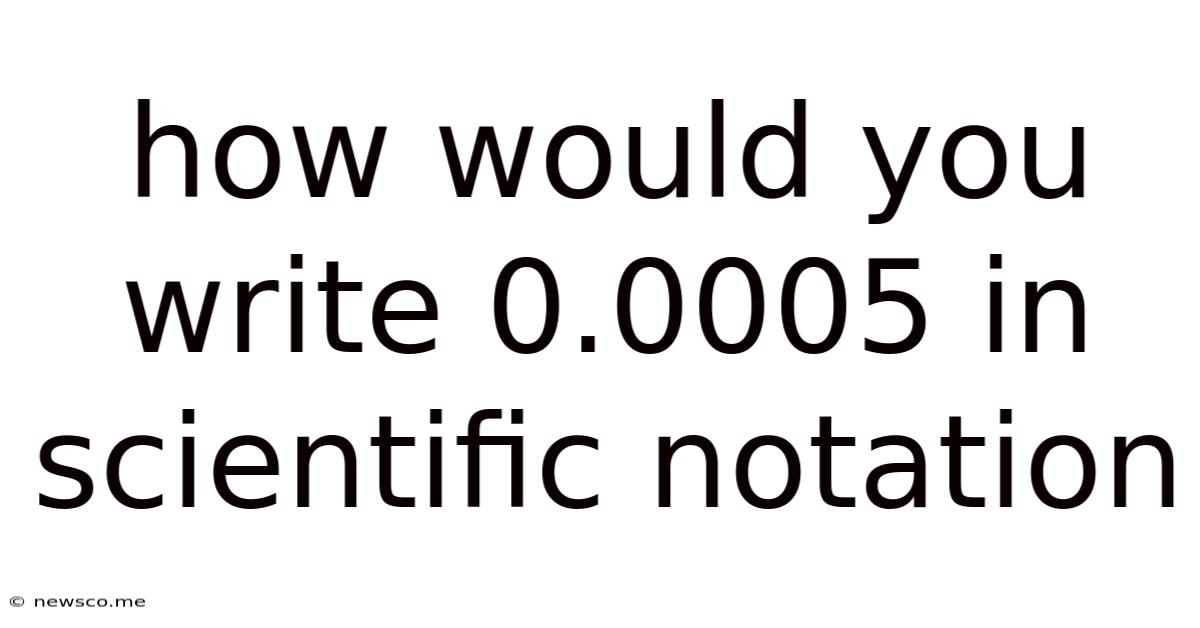How Would You Write 0.0005 In Scientific Notation
News Co
Apr 02, 2025 · 5 min read

Table of Contents
How Would You Write 0.0005 in Scientific Notation? A Comprehensive Guide
Scientific notation is a powerful tool used to represent very large or very small numbers concisely. It simplifies calculations and improves readability, especially when dealing with numbers encountered in fields like science, engineering, and finance. This article will delve into the specifics of converting the decimal number 0.0005 into scientific notation, exploring the underlying principles and providing practical examples. We'll also cover common mistakes to avoid and explore the broader applications of scientific notation.
Understanding Scientific Notation
Before we dive into converting 0.0005, let's establish a clear understanding of scientific notation. The standard form of scientific notation is expressed as:
M x 10<sup>n</sup>
Where:
- M is a number between 1 and 10 (but not including 10 itself). This is often called the mantissa or significand.
- n is an integer (a whole number). This is the exponent. It indicates the number of places the decimal point has been moved.
The exponent's sign indicates the direction of the decimal point movement:
- Positive exponent: The decimal point has been moved to the left. This represents a large number.
- Negative exponent: The decimal point has been moved to the right. This represents a small number (less than 1).
Converting 0.0005 to Scientific Notation: A Step-by-Step Approach
Let's break down the process of converting 0.0005 into scientific notation.
Step 1: Identify the Mantissa (M)
We need to reposition the decimal point so that there's only one non-zero digit to the left of it. In 0.0005, that means moving the decimal point four places to the right. This gives us 5. Therefore, our mantissa (M) is 5.
Step 2: Determine the Exponent (n)
We moved the decimal point four places to the right. Since we moved it to the right, the exponent (n) will be negative. Therefore, n = -4.
Step 3: Write the Scientific Notation
Combining the mantissa and exponent, we get:
5 x 10<sup>-4</sup>
This is the scientific notation representation of 0.0005.
Why Use Scientific Notation? Advantages and Applications
The power of scientific notation lies in its efficiency and clarity, particularly when dealing with extremely large or small numbers. Here are some key advantages:
- Conciseness: Scientific notation significantly reduces the length of numbers, making them easier to read and write. Imagine trying to work with a number like 0.0000000000000000006022 – in scientific notation, this becomes 6.022 x 10<sup>-20</sup>, which is much more manageable.
- Simplified Calculations: Calculations involving very large or small numbers are simpler using scientific notation. Multiplication and division become operations on the mantissa and addition/subtraction of the exponents, making complex calculations easier to handle.
- Improved Readability: Scientific notation makes numbers easier to understand and interpret, especially in contexts where large or small quantities are crucial. The order of magnitude is immediately apparent from the exponent.
- Standard Representation: It provides a consistent way to represent numbers across different fields of study and applications, facilitating easier communication and collaboration among scientists, engineers, and others.
Applications:
- Physics: Representing distances between celestial bodies, the size of atoms, and quantities like Planck's constant.
- Chemistry: Expressing concentrations of solutions (molarity) and the Avogadro's number.
- Engineering: Dealing with signal strengths, microelectronics dimensions, and computer processing speeds.
- Astronomy: Describing the vast distances between stars and galaxies.
- Finance: Handling large sums of money and very small interest rates.
Common Mistakes to Avoid
While scientific notation is straightforward, there are some common mistakes to watch out for:
- Incorrect Placement of the Decimal Point: Ensure that the mantissa (M) has only one digit to the left of the decimal point. A common error is having a mantissa like 50 x 10<sup>-5</sup> instead of 5 x 10<sup>-4</sup>.
- Incorrect Exponent Sign: Remember that a negative exponent indicates a number less than 1, while a positive exponent indicates a number greater than 1. Carefully track the direction of your decimal point movement.
- Ignoring Significant Figures: In scientific calculations, maintaining the correct number of significant figures is crucial. Pay attention to the number of significant digits in the original number when expressing it in scientific notation.
- Incorrect Calculation with Exponents: When multiplying or dividing numbers in scientific notation, remember the rules of exponent manipulation (adding exponents for multiplication, subtracting exponents for division).
Advanced Topics and Further Exploration
Beyond the basics, you can explore more advanced aspects of scientific notation:
- Engineering Notation: A variation of scientific notation where the exponent is always a multiple of 3, aligning well with metric prefixes like kilo, mega, giga, etc.
- Scientific Notation and Significant Figures: Combining scientific notation with the concept of significant figures is crucial for precise scientific calculations.
- Conversion between Scientific Notation and Decimal Notation: Practice converting between both forms to enhance your understanding and fluency.
- Using Scientific Notation in Calculations: Practice applying scientific notation to perform multiplication, division, addition, and subtraction of large and small numbers.
Conclusion
Converting 0.0005 into scientific notation (5 x 10<sup>-4</sup>) is a fundamental skill in scientific and mathematical fields. Understanding the underlying principles, along with avoiding common errors, allows for clear, concise, and accurate representation of numbers, facilitating easier computations and improved communication. This comprehensive guide provided a thorough walkthrough, highlighting the practical applications and emphasizing the importance of scientific notation in various domains. By mastering this skill, you'll enhance your understanding of numerical representation and unlock the power of efficient mathematical computation.
Latest Posts
Related Post
Thank you for visiting our website which covers about How Would You Write 0.0005 In Scientific Notation . We hope the information provided has been useful to you. Feel free to contact us if you have any questions or need further assistance. See you next time and don't miss to bookmark.